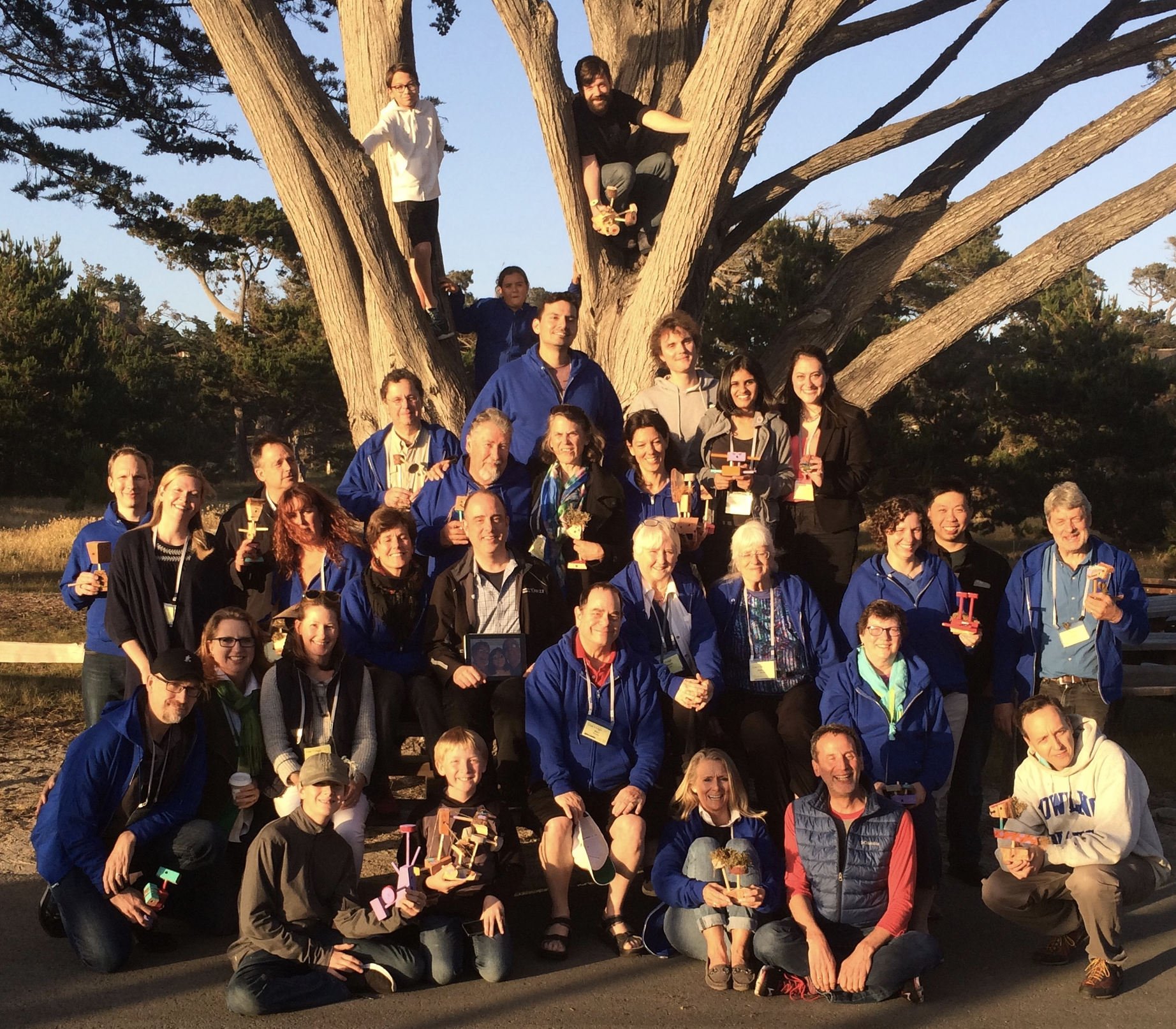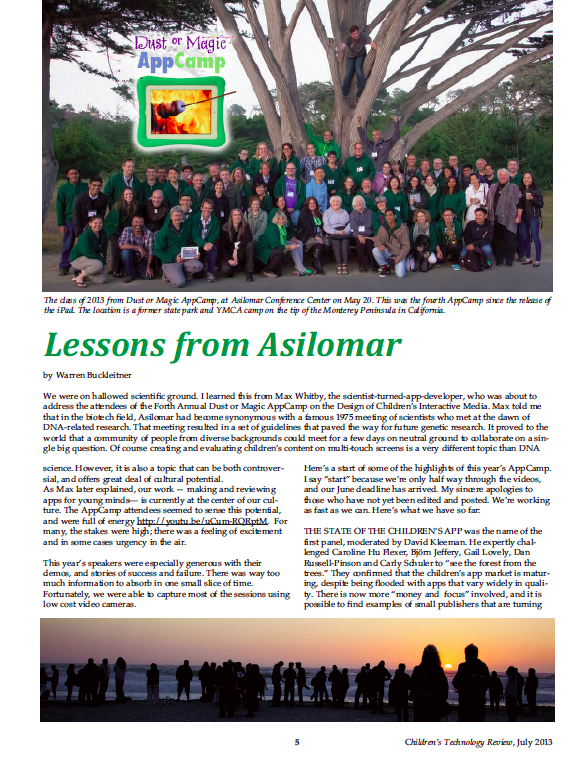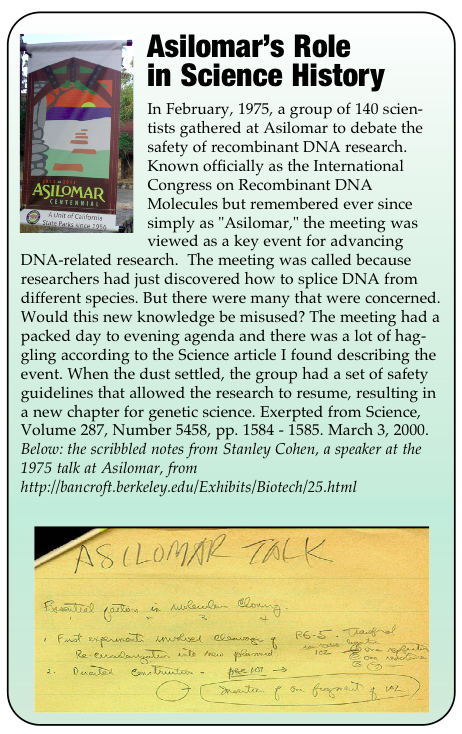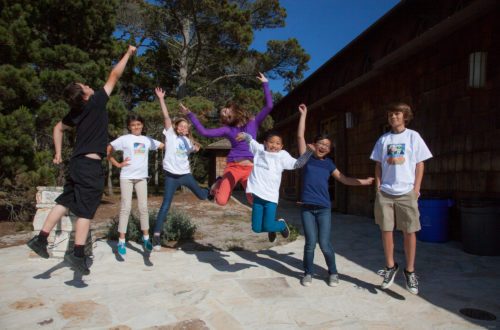
Lessons from Asilomar
 Buckleitner, W. 2013. Children’s Technology Review, June 2013, pages 5-7. Read in PDF format
Buckleitner, W. 2013. Children’s Technology Review, June 2013, pages 5-7. Read in PDF format
We were on hallowed scientific ground. I learned this from Max Whitby, the scientist-turned-app-developer, who was about to address the attendees of the Forth Annual Dust or Magic AppCamp on the Design of Children’s Interactive Media.
Max told me that in the biotech field, Asilomar had become synonymous with a famous 1975 meeting of scientists who met at the dawn of DNA-related research. That meeting resulted in a set of guidelines that paved the way for future genetic research. It proved to the world that a community of people from diverse backgrounds could meet for a few days on neutral ground to collaborate on a single big question.
Of course creating and evaluating children’s content on multi-touch screens is a very different topic than DNA science. However, it is also a topic that can be both controversial, and offers great deal of cultural potential. As Max later explained, our work — making and reviewing apps for young minds— is currently at the center of our culture. The AppCamp attendees seemed to sense this potential, and were full of energy.
For many, the stakes were high; there was a feeling of excitement and in some cases urgency in the air. This year’s speakers were especially generous with their demos, and stories of success and failure. There was way too much information to absorb in one small slice of time. Fortunately, we were able to capture most of the sessions using low cost video cameras. Here’s a start of some of the highlights of this year’s AppCamp. I say “start” because we’re only half way through the videos, and our June deadline has arrived. My sincere apologies to those who have not yet been edited and posted. We’re working as fast as we can. Here’s what we have so far:
THE STATE OF THE CHILDREN’S APP was the name of the first panel, moderated by David Kleeman. He expertly challenged Caroline Hu Flexer, Björn Jeffery, Gail Lovely, Dan Russell-Pinson and Carly Schuler to “see the forest from the trees.” They confirmed that the children’s app market is maturing, despite being flooded with apps that vary widely in quality. There is now more “money and focus” involved, and it is possible to find examples of small publishers that are turning into large publishers. These rapid changes cause both optimism and anxiety. When I asked one publisher how his stress level was on a scale of 0 to 10, he said “12.”
BJÖRN JEFFERY shared five decisions (three good, two bad) that shaped Toca Boca. He served as a reminder that it is possible to build a profitable business making apps, but that it can result in becoming “seriously stressed out.” The Toca Boca formula — to make digital toys with no winning, losing or high scores has worked. Toca Boca has now paid back the initial investment. But it’s not easy and it takes a fair balance of skill and luck. The five decisions were: 1. Good decision: Trusting the team. 2. Bad decision: Thinking others could solve my marketing problems. 3. Good decision: Cancelling projects. 4. Bad decision: Letting technology get in the way of the fun. 5. Good decision: Saying no to 99 percent of all requests.
 MAX WHITBY shared the story of how a bidding war on eBay led him to meet a kindred spirit (Theo Gray) which eventually led to the creation of some periodic table tables, and the app that started Touch Press: The Elements. His early decision to hop in a plane and go and meet Gray in Illinois was pivotal. “There’s much more in life to be gained by collaborating than by competing” he said. Perhaps he had the 1975 meeting in mind when he started his talk in the Asilomar chapel. After being introduced by Aleen Stein, his friend of many years, Max said “We’re in a very exciting period—one of cultural change. What we’re doing—making apps and especially making apps for young minds—is really important, and it’s right at the heart of our culture.” He shared how the ideas at the core of Touch Press have been “shamelessly ripped off “ from the multimedia hypercard period, when Douglass Adams and Tom Baker (the 4th Dr. Who) visualized the potential, years ahead of their time. Jump to the 8:22 segment of the talk http://youtu.be/2CBQkztDDeU?t=8m22s when he plays a segment with Robert Winter talking about “seeing” Beethoven. The message for anyone in the chapel that night was that we have 20 years of pre-tablet digital work to mine, and some of those concepts could be wildly successful in today’s conditions.
MAX WHITBY shared the story of how a bidding war on eBay led him to meet a kindred spirit (Theo Gray) which eventually led to the creation of some periodic table tables, and the app that started Touch Press: The Elements. His early decision to hop in a plane and go and meet Gray in Illinois was pivotal. “There’s much more in life to be gained by collaborating than by competing” he said. Perhaps he had the 1975 meeting in mind when he started his talk in the Asilomar chapel. After being introduced by Aleen Stein, his friend of many years, Max said “We’re in a very exciting period—one of cultural change. What we’re doing—making apps and especially making apps for young minds—is really important, and it’s right at the heart of our culture.” He shared how the ideas at the core of Touch Press have been “shamelessly ripped off “ from the multimedia hypercard period, when Douglass Adams and Tom Baker (the 4th Dr. Who) visualized the potential, years ahead of their time. Jump to the 8:22 segment of the talk http://youtu.be/2CBQkztDDeU?t=8m22s when he plays a segment with Robert Winter talking about “seeing” Beethoven. The message for anyone in the chapel that night was that we have 20 years of pre-tablet digital work to mine, and some of those concepts could be wildly successful in today’s conditions.
DAN RUSSELL-PINSON, like many successful children’s app developers, doesn’t have a formal educational background. However, his apps, including Math Bingo (2009) and Stack the States (2010) have become well known in US classrooms. In his talk, Pinson told us “when you hear an artist talk about their craft they don’t describe themselves as being creators. It’s more that they’re a conduit. You have to get out of the way.” He went on to talk about two steps to making magic (1) create an environment where magic can happen, and (2) be mindful enough to notice when it does happen. Interestingly Pinson’s steps are very similar to the way many teachers talk about creating an optimal classroom learning environment. Perhaps he’s more of an educator than he thinks.
BARRY O’NEIL of StoryToys took the conversation about the business of children’s app publishing up a notch, introducing the concept of ROI, or Return On Investment in the context of what he’s learned making the StoryToys apps. O’Neil was accompanied by the creative director of his apps, Jim Pipe. O’Neil’s talk has yet to be edited; make sure to check it out when it is ready.
That’s it for now. We’re less than half way through uploading the videos, but are making excellent progress. It is our hope that — like the meeting in 1975 — we can help the field along freely exchanging quality information. “Good information is lubrication for change.”
Some select tweets:
- The scarcity is no longer capital. It’s talent. Jib Jab Media CEO Gregg Spiridellis.
- Kids’ exploratory play is not a bug. It’s a feature. @NoodleWorks #dustormagic pic.twitter.com/cf2X8iuhjS
- If you’re going to fail, at least fail big. Otherwise it seems like you haven’t even tried. Caston Almqist, former Chairman of Toca Boca in a slide show by Bjorn Jeffery.
Video Guide Here’s a listing of the AppCamp 2013 videos online so far.
- David Kleeman et al: State of the Children’s App Panel http://youtu.be/ee5KMYUkVL0
- Björn Jeffery: Five decisions that shaped Toca Boca http://youtu.be/JPw8WHENTJE
- Max Whitby: Amazing, but true — the 40+ year overnight success of Touch Press http://youtu.be/2CBQkztDDeU
- Dan Russell-Pinson: Letting Magic Happen http://youtu.be/a16wuluJUdU
- Carly Shuler: Thoughts on ebooks vs. apps and some “Make Your Own Research.” http://youtu.be/pm0GOyDV-ZM
- Gail Lovely: Poof! Chalk dust or Magic dust? What educators are waiting for in apps. http://youtu.be/MM4NgoS-idk
- Greg Spiridellis of Jib Jab Media: The driving inspiration behind the StoryBots http://youtu.be/PqgmSBep-7g
- Caroline Hu Flexer of Duck Duck Moose. The past, present and future, from a DDM point of view http://youtu.be/Yowrm0pm9gI
Check the latest Dust or Magic demos and videos here:



